Sprouted Barley Grains on Olive Cake and Barley Straw Mixture as Goat Diets In Sinai
The present research was aimed to study the effect of sprouted barley grains (Hordeum vulgare L.) on different levels of olive cake (OC) and barley straw as media. A laboratory study was conducted to show the performance of sprouted barley grain on tested roughages media by fodder yield and conversion ratio values; followed by five digestibility trials which conducted to evaluate the digestibility of experimental roughages by using twenty five desert male goats (20 months old) with average 22.50±2.54kg live body weight. Animals were randomly divided into five equal groups of 5 animals each to receive one of the following experimental roughages G1: alfalfa ad libitum as (control); G2: sprouted barley grains on 75% olive cake (OC) + 25% barley straw (BS) ad libitum; G3: sprouted barley grains on 50% olive cake (OC) + 50% barley straw (BS) ad libitum; G4: sprouted barley grains on 25% olive cake (OC) +75% barley straw (BS) ad libitum; G5: sprouted barley grains on 100% barley straw (BS) ad libitum. The best treated group from the results of digestibility trail was conducted feeding trail. Results showed that the treatments with sprouted barely increase CP, ash and C.CHO contents while DM, OM, EE, CF, NDF, ADF and ADL contents were decreased. Sprouted barely on olive cake or barley straw revealed a significant (P≤0.05) improvement in OM, CP, EE, CF, NFE, NDF, ADF and hemicellulose digestibility. Nutritive values expressed as TDN g/Kg BW and DCP% increased significantly (P≤0.05) in treated groups G1 and G2 followed by G3, G4 and the lowest values were in G5. Also, goats fed the four sprouted mixture recorded higher significantly (P≤0.05) of N balance compared with G1 (control group) with insignificant differences in Na and K balance (g/kg BW) values between studied groups. Goats fed sprouted barely had significantly (P≤0.05) higher values of total volatile fatty acids (VFA's) and ruminal ammonia (NH3-N) concentration post feeding with 3 hours. Serum total proteins, albumin, globulin, urea and creatinin were increased (P≤0.05) compared with untreated roughages. Feed cost LE/gm gain was improved by goats fed on G2 and G3 with percent (34.15 and 32.52% respectively) in compared to control diet. Relative economical efficiency was improved by 90.77% in G2 comparison with the control diet. In conclusion we can produce green fodder by utilizing dried olive cake and barley straw by simple methodology using crop sprouts barley without any harmful effect on goats.
Keywords: Olive cake, barley straw, sprouted barley, goats, growth, rumen and blood parameters.
G2: sprouted barley grains on 75% olive cake (OC) + 25% barley straw (BS) ad libitum.
G3: sprouted barley grains on 50% olive cake (OC) + 50% barley straw (BS) ad libitum.
G4: sprouted barley grains on 25% olive cake (OC) + 75% barley straw (BS) ad libitum.
G5: sprouted barley grains on 100% barley straw (BS) ad libitum.

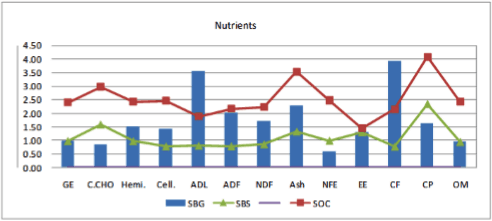

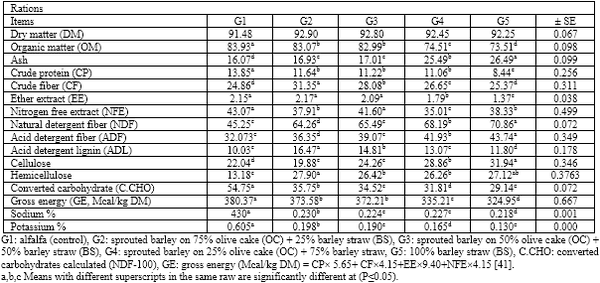
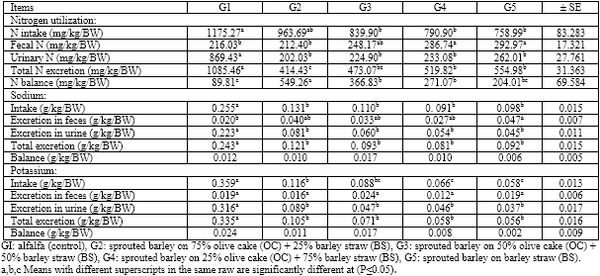

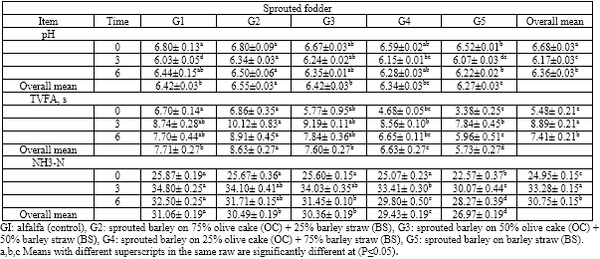

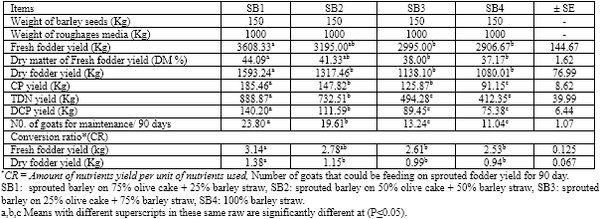


1. ESNC, 2010. Egypt Second National Communication Under the United Nations Framework Convention on Climate Change, UNFCCC, Published by Egyptian Environmental Affairs Agency (EEAA), 2010. FAO, 1980. Soil and Plant Analysis. Soils Bulletin, 38: 242-250.
2. Delgado, C., 2005. Rising demand for meat and milk in developing countries: implications for grasslands-based livestock production. In Grassland: a global resource (ed. D. A. McGill way), pp.: 29- 39. The Academic Publishers.
3. El-Kerdawy, D.M.A., 1997. Olive pulp as a new energy source for growing rabbits. Egyptian J. Rabbits Sci., 7: 1-12.
4. Moustafa, S.M.S., A.A.S. Mahgoub, M.T. Sallam, A.A. Abd El-Ghani and T.A. Deraz, 2008. Evaluation of olive pulp waste for Egyptian buffaloes. J. Agric. Sci. Mansoura Univ., 33: 1745-1755.
5. Information Center of South Sinai Governorate, 2014. Agricultural Department, Information Center of South Sinai Governorate. El-Tour, Egypt, March, 2014.
6. Vlyssides A.G., M. Loizides and P.K. Karlis, 2004. Integrated strategic approach for reusing olive oil extraction byproducts. J. Cleaner Prod., 12: 603-611.
7. Sansoucy, R., X. Alibes, P.H. Berge, F. Martilotti, A. Nefzaoui and P.Zoïopoulos, 1985. Olive by- products for animal feed. Food and Agriculture Organization of the United Nation, Rome, © FAO.
8. Nefzaoui, A., 1983. Etude De L'utilisation Des Sous-produits De L'olivier En Alimentation Animale En Tunisie. Animal Production and Health.
9. Martín García, A.I., A. Moumen, D.R. Yáñez Ruiz and E. Molina Alcaide, 2003. Chemical composition and nutrients availability for goats and sheep of two-stage olive cake and olive leaves. Anim. Feed Sci. Technol., 107: 61-74.
10. Filya, I.H. Hanoglu, Ö. Canbolat and E. Sucu, 2006. Researches on feed value and using possibilities in lamb fattening of dried olive-cake 1. Effects on fattening performance of lambs. Uludag. Üniv. Zir.Fak. Derg., 201: 13-23.
11. Teimouri Yansari, A., H. Sadeghi, Z. Ansari-Pirsarai and H. Mohammad-Zadeh, 2007. Ruminal dry matter and nutrient degradability of different olive cake by-products after incubation in the rumen using nylon bag technique. Int. J. Agric. Biol., 9: 439-442.
12. Van Hao N and Ledin I., 2001. Performance of growing goats fed Gliricidia maculata, Small Ruminant Res. 39: 113-119.
13. Rodriguez-Mulea, C., Rodriguez, H. E., Ruiz, O., Flores, A., Grado, J. A. and C. Arzola, 2004. Use of green fodder produced in hydroponic system as supplement for lactating cows during the dry season. Proceedings of the American Society of Animal Science, 56, 271-274.
14. Fazaeli H., H. A. Golmohammadi., S.N. Tabatabayee and M. Asghari-Tabrizi, 2012. Productivity and nutritive value of barley green fodder yield in hydroponic system. J. Agr. Sci. Tech. 16 (4): 531-539.
15. Al-Karaki, G. N., 2010. Hydroponic green fodder: alternative method for saving water in dryareas. Proceedings of the"Second Agricultural Meeting on Sustainable Improvement of Agricultural and Animal Production and Saving Water Use. September 2010, Sultanate of Oman.
16. Tudor, G., Darcy, T., Smith, P. and F. Shallcross, 2003. The intake and live weight change of drought master steers fed hydroponically grown, young sprouted barley fodder (Auto Grass). Department of Agriculture Western Australia.
17. Amal B.K, Z. Aurang, B. Nizakat, A.K. Shahid and S.K. Mohammad, 2007. Influence of germination techniques on phytic acid and polyphenols content of chickpea (Cicer arietinum L.) sprouts. Food Chem. 104: 1074-1079.
18. Bustos, C. D. E., E. L. Gonzalez., B. A. Aguilera and G. J. A. Esptnoza, 2000. Forraje Hidropónico, Una Alternativa para la Supplementation Caprina En el Semi desire to Queretano. XXXVIII. Reunión Nacional de Investigación Pecuaria. Puebla, México, 383 PP.
19. Mohammadi, F., Thanaa and M.M. F. AbdalLah, 2007. Effect of four seed sprouts on rice straw and spent mushroom media of rice straw to be used as a green fodder. Egyptian J. Nutrition and feeds, 10 Special Issue: 679-691.
20. Farid, M. F.A.; H.M. Abou El-Nasr and N.I. Hassan, 1986. Effect of dietary available carbohydrate level on feed and nitrogen utilization in sheep given urea in the drinking water. World Rev. of animal Prod., 12:3.
21. Kearl, L.C., 1982. Nutrient Requirements of Ruminants in Developing Countries. Utah Agric. Exp. St., Utah State Univ. Logan, UT, U. S. A.
22. A.O. A. C., 1997. Official Methods of Analysis. 16th Ed. Assoc. Office. Anal. Chem., Arlington, VA.
23. Goering, H.K. and P.J. Van Soest, 1970. Forage fiber analysis. Agricultural Handbook, No. 379, USDA, Washington. DC, U. S. A.
24. Warner, A.C.J., 1964. Production of volatile fatty acids in the rumen methods of measurements. Nutr. Abs. and Rev. 34: 339.
25. Jackson, M.L., 1958. Soil Chemical Analysis. Constable and Company, Ltd, England.
26. Armstrong, W.D. and C.W. Carr, 1964. Physiological chemistry. Laboratory Direction, 3 rd ed., P. 75, Burges bublishing Co. Minneapolis, Minnestota. Artificially Grown Barley Fodder by Sheep. Indian J. Small Rumen, 4 (2): 63-68.
27. Doumas, B., Wabson, W. and Biggs H., 1971. Albumin standards and measurement of serum with bromocresol green. Clin, Chem., Acta.
28. Henry, R.J., 1965. Clinical Chemistry. Principles and Technics, P. 293.
29. Patton, C.J., and Crouch S. R., 1977. Enzymatic determination of urea by calorimetrically Method Anal. Chem., 49: 464.
30. SAS, 1998. User guide: statistics version 6, 4th ed., Vol. 2 SAS Institue Inc., Cary. NC. USA.
31. Duncan, D.B., 1955. Multiple ranges and multiple. F. Tests Biometrics. 11, 1-42.
32. Hepbasl, A., R.C. Akdeniz, F. Vardar-Sukan and Z. Oktay, 2003.Utilization of olive cake as a Potential energy source in turkey. Energy Sources, 25: 405-417.
33. Canbolat, Ö., A. Karabulut and F. Gürbüzol, 2003. Zeytin Agaci Dal Ve Yapraklari Ile Zeytin Küspesinin Yem Degerinin in Vivo Ve in Vitro Yöntemlerle Saptanmasi, pp: 332-342. III. Ulusal Zootekni Bilim Kongresi, Ankara.
34. Shaker A. Hassan, Sarwar M Saiq, Khasraw M. Hassan, 2011. Effect of feeding chemical and microbial treated barley straw on performance and some serum biochemical attributes of karate lambs KSU J. Nat. Sci., 14(3).
35. Morgan, J., R.R. Hunter and R. O'Haire, 1992. Limiting factors in hydroponic barley grass production. In the proceeding of the 8th International Congress on Soil less Culture, pp: 241-261.
36. Fayed, M. Afaf, 2011. Comparative study and feed evaluation of sprouted barley grains on rice straw versus Tamarix mannifera on performance of growing barki lambs in Sinai Journal of American Science, 7 (1), 954-961.
37. Helal, H. G., 2012. Sprouted barley grains on rice straw and Acacia saligna and its effect on performance of growing barki lambs in Sinai. Proc. of the 5th Animal Wealth Research Conf. in the Middle East & North Africa1-3: 331-346.
38. Helal, H.G. and Mona M. Hassan, 2013a. Sprouted zea mays on date palm leaves and potatoes peel waste mixture and its effects on performance of desert goats under dry season in Sinai. J.Animal and poultry prod., Mansoura Univ., Vol.4 (3):117-132.
39. Helal, H.G. and Mona M. Hassan, 2013b. Effect of sprouted corn grains on leucaena tree pruning and olive tree pruning diets for desert goats under Sinai condition. J.Animal and Poultry Prod., Mansoura Univ., Vol.4 (3):133-147.
40. Lorenz, K., 1980. "Cereal sprouts: composition, nutritive value, food applications." Crit. Rev. Food Sci. Nutr. 13 (4): 353-385.
41. Blaxter, K. L., 1968. The energy metabolism of ruminants. 2nd Ed. Hutchinson and Co. Lted. London.
42. Fazaeli H., H. A. Golmohammadi., A. A. Shoayee., N. Montajebi and Sh. Mosharraf, 2011. Performance of Feedlot Calves Fed Hydroponics Fodder Barley J. Agr. Sci.Tech. 13: 367-375.
43. Trubey, C. R., Rhykerd, C. L., Noller, C. H., Ford, D. R. and George, J. R., 1969. Effect of light, culture solution, and growth period on growth and chemical composition of hydroponically produced oat seedlings. Agron. J., 61 (5): 663-665.
44. Molla, A. and D. Birhan, 2010. Competition and resource utilization in mixed cropping of barley and durum wheat under different moisture stress levels. World Journal of Agricultural Sciences, 6 (6): 713- 719.
45. Chavan, J. and S.S. Kadam, 1989. "Nutritional improvement of cereals by sprouting." Critical Reviews in Food Science and Nutrition, 28 (5): 401-437.
46. Mayer, A. M. and A. Poljakoff-Mayber, 1975. The germination of seeds. 2nd Edition, Pergamon Press, Toronto.
47. Chung, T., Nwokolo, E.N. and J.S. Sim, 1989. Compositional and digestibility changes in sprouted barley and canola seeds. Plant Foods for Human Nutrition, 39:267-278.
48. Dikshit, M. and Ghadle, 2003. Effect of sprouting on nutrients, anti- nutrients and in vitro digestibility of MACS.13 soybean variety. Plant Food Hum. Natr, 58: 1-11.
49. Shipard I., 2005. How can I grow and use sprouts as living food? Stewart publishing.
50. Bamforth, C.W., 1982. Barley β-glucans, their role in malting and brewing. Brewers Digest. 57: 22-27.
51. Church, D. C. and W. G. Pond, 1982. Basic Animal Nutrition and Feeding, 2 nd ed. JohnWiley and Sons, New York, U. S .A.
52. Allam, Sabbah M.; Youssef, K. M.; Ali, M. A. and Abo Bakr, S. Y., 2006. Using some fodder shrubs and industrial by-products in different forms for feeding goats in Sinai. J.Agric. Sci. Mansoura Univ., 31: 1371-1385.
53. Bonsi, M. L. K., P. O. Osuji and A. K. Thuah, 1995. Effect of supplementing tef straw with different level of leucaena or sasbania on the degradability of tef straw, sesbania, leucaena, tagaste and vernonia and certain rumen and blood metabolites in Ethopianmenz sheep. Anim. Feed Sci Technol 52; 101-129.
54. Norton, B.W., 2003. The Nutritive value of tree legumes. In: Forage Tree Legumes in Tropical Agriculture, Gutteridge R.C and Shelton H.M, (eds). pp.43.
55. Bohnert, D.W., C.S. Schauer, S.J. Falck and T. DelCurto, 2002. Influence of rumen protein degradability and supplementation frequency on steers consuming low-quality forage: I. Ruminal fermentation characteristics. J. Anim. Sci., 80: 2978-2988.
56. Salisbury, M.W., C.R. krehbiel, T.T. Ross, C.L. Schultz and L.L. Melton, 2004. Effects of supplemental protein type on intake, nitrogen balance and site and extent of digestion in white face wethers consuming low-quality grass hay. J. Anim. Sci., 82:3567-3576.
57. Ibrahim, A. Fathia, Hoda, M. El-Hosseiny and I. M. El-Sayed, 2001. Effect of using sprouted barley by recycle process of agriculture residues on feeding value, rumen activity and some blood constituents of crossbred sheep. Egyptian J. Nutrition and feeds, 4 (Special Issue) 265-273.
58. Kumar, N.U., S. Singh and D. N. Verma, 1980. Effect of different levels of dietary protein and energy on growth of male buffalo calves. Ind. J. Anim. Sci., 51: 513.
59. Elisabetta, M., R. Marco., M. Fabrizio., R. Giuseppe., M. Giuseppe and Z. Antonia, 2009. Improvement of sheep welfare and milk production fed on diet containing hydroponically germinating seeds. Ital. J. Anim. Sci., 8 (Suppl. 2); 634-636.
60. Bautista, S.H., 2002. Producción de forraje verde hidropónico de trigo Triticum aestivum L. para el mantenimiento de conejos criollos Oryctolagus cuniculus. MSc thesis, Universidad Autónoma de Guerrero (UAG) Chilpancingo, Guerrero, México.
61. Eshtayeh, F.A. Intissar, 2004. A new source of fresh green feed (hydroponic barley) for awass sheep. Master in Environmental Sciences, Fac. of Graduate Studies, at Najah National Uni., Nablus, Palestine. 62. Kruglyakov, Yu. A., 1989. Construction of equipment for growing green fodder by a hydroponic technique. Traktory-I Sel'skokhozyaistvennye Mashiny, 6 (1): 24-27.
63. Mohamed, Sh. H., 2005. Biological treatment of sugar beet pulp and its use in sheep ration. M. Sc. Thesis. Fac. of Agric., Cairo Univ.
64. Abedo, A.A.A., 2006. A study on the use of sugar beet pulp in the feed mixtures for ruminants. Ph. D Thesis. Agric. Sc., (Animal Nutrition), Department of Animal Production, Faculty of Agriculture, Ain Shams University.
65. Mousa, M.R.M., 2011. Effect of partial replacement of dietary concentrate feed mixture by fodder beet roots on productive performance of ewes and doe goats under the conditions of North Sinai. Asian Journal of Animal Sciences, 5: 228-242.







_1.jpg&w=3840&q=75)